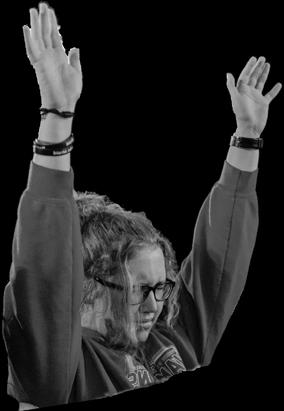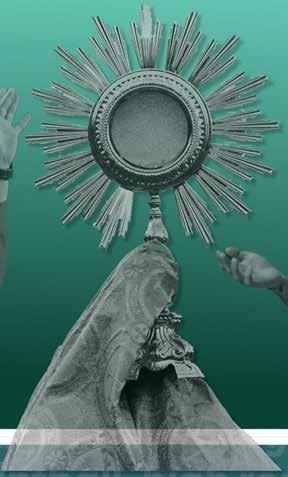
6 minute read
The Real Presence from Jerusalem to Emmaus (and Back)
Among Catholics, an emphasis on one true aspect of Communion often leads to the denigration (if not effective denial) of another true aspect of Communion. Some Catholics emphasize the Real Presence of Christ on the altar at the words of consecration, but ignore the Eucharist’s community-forming nature. Others emphasize Communion’s community-forming nature, but downplay (or even deny) the Real Presence of Christ in the Host. A closer look at a less obvious Gospel account of the Eucharist illustrates how both aspects should be embraced and celebrated, and why we should resist this “either/or” error.
Catholics are familiar with the words of consecration in the Liturgy of the Eucharist during Mass: “Take this, all of you, and eat of it: for this is my body which will be given up for you.” These words are taken from the Gospel accounts of Jesus’ institution of the Eucharist on Holy Thursday, the night before his crucifixion, “on the night he was betrayed” (Eucharistic Prayer III). While the center of our Eucharistic liturgical celebration, this prayer is not the New Testament’s only Eucharistic reference. In the Gospel of Luke, another Eucharistic event helps flesh out our understanding of both the Real Presence and the celebration’s community-forming nature.
Advertisement
In Luke 24, after the crucifixion two disciples returned from Jerusalem to their home in the nearby town of Emmaus. Jesus met them along the road and asked what they were discussing, but was not recognized by the disciples. They explained their disappointment of the previous days’ events, when their hoped-for Messiah was executed by the Roman authorities, mass confusion followed and His body disappeared. “We were hoping that he would be the one to redeem Israel,” one of them bemoaned. As they walked together Jesus explained that these events were prophesied in the Hebrew Bible, and it was necessary for them to occur.
They reached Emmaus and Jesus began to move on, but the disciples urged Him to stay at their house. When they sat down to eat, something unexpected happened. Rather than the hosts offering a blessing for the food and feeding their guest, Jesus himself “took bread, said the blessing, broke it, and gave it to” the disciples. In other words, the disciples provided the gift of bread, but it was Jesus who gave thanks and fed His followers with the blessed food. And it was not only (or even primarily) physical nourishment they received from the meal, but spiritual sustenance. “Their eyes were opened and they recognized” Jesus as their Messiah, explains the evangelist. In other words, Jesus’ presence became real to them when He blessed, broke, and fed the bread to them. And at the very moment of recognition, Jesus “vanished from their sight.”
Amazed by what they experienced, the Emmaus disciples immediately set out for Jerusalem to tell Jesus’ other followers what happened. They went to the remaining 11 apostles and “recounted how [Jesus] was made known to them in the breaking of the bread” (emphasis added). Even as the Emmaus disciples were recounting their experience, Jesus “stood in their midst and said to them, ‘Peace be with you.’” Jesus appeared to the community of believers at the very moment the disciples were explaining that He had appeared to them in the breaking of the bread. While we celebrate Pentecost as the “birthday of the Church,” we clearly see her embryonic form in this gathering of believers around Christ in their midst.
The parallels to the events at Mass are not accidental. We bring the bread to the altar in our local parish (our house), where we offer it to our Lord. The priest, in persona Christi, gives thanks, blesses the bread, and feeds us who brought it. In the breaking of the bread, we recognize Jesus, really present and really known. And in His Real Presence on the altar, Christ gathers the community around Himself. Finally, after the consecration and Lord’s Prayer, the priest (again, in persona Christi) says, “Peace be with you,” just as Jesus said to the community of disciples in Jerusalem after the pair returned from Emmaus.
We rightly associate the Liturgy of the Eucharist with the Last Supper on Holy Thursday. But the Emmaus story deepens and enriches our understanding of the Eucharist, illustrating both the Real Presence of Christ and the communal nature of the liturgy. We must not succumb to an “either/or” mentality. The Church teaches that the Eucharist is both the real presence of Christ on the altar and the formation of the community we call the Church. A journey to Emmaus and back reminds us of both these important truths.
Catholic Charities Southwestern Ohio serves and empowers people through God’s love in their times of vulnerability. We do so through a full range of local services that engage the community in building solidarity. Serving more than 15,000 people each year, we provide food assistance, senior and caregiver support, mental health counseling, family and parenting education, comprehensive services for migrant and refugee families, and much more. Our mission is enabled by all those who generously pray, learn, volunteer and donate. Interested in volunteering or having us pray for you? Visit www. ccswoh.org!
Interested in supporting our programs? DONATE securely online at ccswoh.org or mail in your donation.
What Are You Hungry For?
Imagine for a moment that you are Satan. You’re the master deceiver, the father of lies, diabolical, and you’re fully set on stealing as many souls from God as possible.
How would you do it? I’m sure we could imagine a thousand different ideas, but let me propose one strategy we can witness at play in today’s world. First, let’s consider how the Church has grown and spread throughout history. A primary mode of growth for Christianity has been through acts of love and service. This should be no surprise as it’s the model Jesus established.
In the Gospels, we see that Jesus almost always addresses a human need before addressing a spiritual need. He heals and drives out demons, then He preaches the beatitudes. He feeds thousands, then He gives the Bread of Life discourse. He stops a crowd from stoning an adulteress to death, then tells her to go and sin no more. He calms the storm, then challenges His disciples to have greater faith.
Through a similar model, the Church has grown throughout history. Faithful disciples cared for the poor and lowly. Missionaries traveled to new lands where they built hospitals and schools. Immigrants found welcome and family in small faith communities. And while addressing these human needs, the disciples preached the Good News of Jesus Christ. Wherever you find Christianity spreading, you find missionary disciples clothing the naked, feeding the hungry, caring for the sick, teaching the ignorant, visiting the imprisoned and sheltering the homeless.
So, what diabolical plan would stop Christianity’s spread in its tracks? Build a world where nobody needs anything.
Of course, I am painting with broad strokes, but many in our communities don’t want for life’s necessities. Maybe we can’t afford that Corvette we’ve always dreamed of, but most of us have food, clothing and shelter. We have access to education. We can show up at a hospital and someone will care for us. We have seemingly limitless access to entertainment and comfort right at our fingertips. It’s a truly diabolical plan. It leaves many people asking, “Why would I ever need Church?” And that question is only a short step from, “Why would I ever need God?”
The Eucharist is God’s gift of Himself for our salvation, but notice how Jesus spoke about the Eucharist in Scripture. He told people that if only they would eat this bread, they’d never be hungry again! If only they would drink this wine they’d never be thirsty again. These were people who experienced hunger and thirst in a way most of us never have, and likely never will! Today, Jesus’ promise often falls on deaf ears: I’m never hungry anyways, so why do I need your Living Bread?
If you ever struggled with your belief in the Eucharist or your personal relationship with the Eucharist, try this: Allow yourself to go hungry and see how that changes things for you. You can focus on fasting for one hour before Mass, but you could also try other ways to make yourself “hungry.”
• Try eating or drinking nothing but water from bedtime on Saturday night until after Mass on Sunday morning.
• Try giving a little more financially than you normally do—a 1% increase is a good place to start.
• Try setting the thermostat two degrees colder.
• Make one small sacrifice every day, like drinking one less cup of coffee, eating the salad instead of the cheeseburger, or foregoing the radio while driving in the car.

Our modern culture feels like we don’t really need anything— including God. It’s a diabolical plan. And so, it might just be that the best way to grow closer to the Eucharist is to remember what it feels like to hunger.
DOMINICK
ALBANO
is The Catholic Telegraph’s director of digital engagement, an author and national speaker. He and his wife have been married for 15 years and have four sons. dalbano@catholicaoc.org









